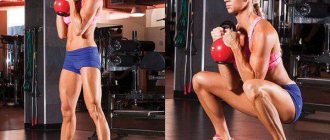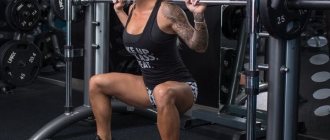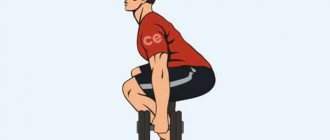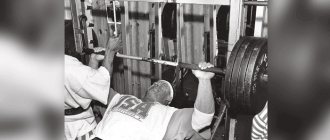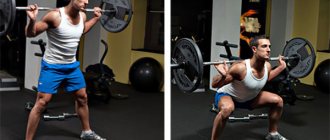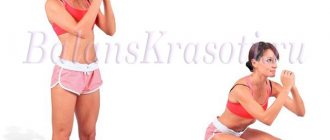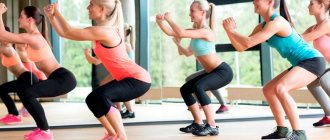Why squat like that?
The most valuable benefit of weighted plie squats is the pumping of the buttocks and inner thighs. Moreover, by varying the depth of the squat, you can use more of the buttocks or quadriceps of the legs. This is relevant for girls who want to pump up their buttocks without particularly increasing the massiveness of their legs. We’ll tell you how to achieve both of these a little later.
Anyone who has already been to the gym knows how girls work on the problematic inner thigh - in a machine for bringing and spreading legs. So, plié needs to be done before this. This is the main exercise for local development of the inner thigh. Then you should get on the simulator. The exercise is designed for dumbbells or weight plates.
Squat Efficiency
This type of squat is very effective in its own way. That is why so many girls and women who dream of tightening their upper thighs use this exercise. Many men who go to the gym believe that such an exercise is completely useless. But if you follow the correct plie squat technique, it can be effectively used as a basic exercise to increase muscle mass. Or you can make the plie isolated and create an emphasis on the inner thigh. This area is very important for any woman, as it is the most problematic.
If a woman performs this exercise, she will be able to achieve the following results:
- Will tighten the inner thighs.
- Rounds the buttocks.
- It will work several muscle groups at once.
- Will help relieve stress on the knee joints.
- Improves the coordination of your movements.
- Will get the opportunity to unload your spine.
- He will be able to study at home.
- Absolutely any type of equipment will be used during training.
The plie exercise can also be suitable for men. If you perform the exercise correctly, you can significantly develop the large muscles of the lower body, which is what many male athletes try to achieve.
Preparing for the exercise
Have you seen girls in the gym who, with their legs spread wide and holding a dumbbell above the floor, squatted? This is what plié is. For those who haven’t seen it, be patient, everything will be described in detail in the “execution technique” section.
- Stretching is the most important thing in the plie squat. The fact is that you will not be able to turn your knees normally or squat deeply enough if your ligaments are not ready for such an amplitude of movement. Therefore, next we will analyze what and how to pull so that the technique is close to ideal.
- Cloth. A separate conversation about pants. They should not restrict your movements. You need to choose clothes in which you can do the splits. Haven't sat down yet? Everything is ahead, don't be upset.
- Shoes must be stable and have hard soles. If you have weightlifting shoes, you can wear them.
Contraindications
Squats with dumbbells between your legs are a completely safe alternative to training with a barbell. Indeed, in this case, the load on the spine is significantly reduced. However, such activities are contraindicated for recent injuries to the knees and lower back, as well as hernia and radiculitis. In addition, you should perform squats with caution if you have varicose veins and a weak cardiovascular system.
Features of stretching before squats
To perform the exercise correctly, you need to stretch the ligaments of the legs and lower back. We pull the lower back in the classic way - we reach the floor with our hands on straight legs. Here's another good way to stretch your lower back: sitting on the floor. Details in a special article on back stretching.
Leg stretching is best done on a wall bars. Walk up to her and raise your leg as high as you can. Straighten your leg. Bend in different directions, stretch the ligaments. Fix your body in those positions where you experience barely noticeable pain. There is no need to go further.
Sit on the longitudinal and transverse splits. Also, one of the main ways to stretch in this case is to sit on the floor, spread your knees to the sides, and reach them to the floor. Press with your hands from above until your knees touch the floor.
Incorporating plie squats into your training program
This exercise can be performed in two modes:
- Nailing . In this case, plie squats are done at the end of the workout. Multi-repetition is best. This is where 12-20 times with light weight, for 3-4 approaches. You can also insert this exercise into supersets and double sets. For example, we perform a LYING LEG PRESS, and then achieve it with plie squats. But these are more professional methods. For beginners, it’s best to start with classic linear training.
- Power. Here we are already working with solid weights, so the number of repetitions will have to be reduced to 8-12, also by 3-4 approaches. In this case, the first one must be a warm-up exercise. Now you can perform plie squats on a par with basic ones. But for me it’s better to do squats with a barbell on your back first. However, this exercise is more powerful and requires a lot of energy.
There are also fitness training programs consisting of different types of plie squats. But we will not analyze this within the framework of this article.
As you can see, the exercise has a large number of advantages and is worthy of being noticed. And don't forget to stretch at the end of your leg workout. This will help your muscles and joints become more elastic over time. And you can easily perform these squats.
Good luck to everyone in your training!
Exercise technique
The most important thing is to learn how to sit down correctly. Let's start training with the minimum weight that you have in your gym or at home. Let it be a 1 kg dumbbell that you can comfortably grip with your hands.
- We take the dumbbell with both hands so as to hold it by one of the edges. The dumbbell should hang freely perpendicular to the floor, the bar passes between the fingers.
- Place your feet with your toes apart, as if you were a ballerina. Only they place their legs almost together, and you place them a little wider than shoulder-width apart. Turn your socks out to the sides as much as possible. The more the toes are turned out, the more stress will be placed on the inner thigh. In particular, the position of the feet of plie differs from sumo (in sumo, the socks turn about 45 degrees).
- We straighten our back, move our pelvis back a little, creating a natural deflection in the lower back.
- We look slightly upward (usually they suggest looking at the line between the ceiling and the wall that is opposite you).
- We begin to lower the pelvis down. Keep your knees pointing in the same direction as your feet (which is why we warned you that a good stretch will be needed). We squat to the maximum - below parallel with the floor. We don’t swing dumbbells back and forth!
- After reaching the bottom point, we begin to get back up. We go down as we inhale, we rise as we exhale. It is important that the movements are smooth.
- We don’t fully extend our legs! You need to maintain muscle tension throughout the exercise.
- The weight is kept perpendicular to the floor between the legs at all times.
The exercise technique is not the most difficult, but a lot of mistakes are made.
Technique for performing plie squats with a dumbbell between the legs[edit | edit code]
Plie squat with a dumbbell between the legs
At first glance, it seems that the exercise is simple, to some extent this is true, but mistakes are often made in it, which negate all the positive effects of its implementation. Therefore, we learn the correct technique, which is the following sequence of steps.
- Stand up straight, statically tense your abs and pick up a dumbbell with an overhand grip on the weight plate (at the base). Stand with your feet wider than shoulder-width apart, knees slightly bent, and feet pointed outward (to about a 45-degree angle). Place the dumbbell between your legs. This is your starting position.
- As you inhale, begin to pull yourself down, slowly bending your knees. Lower yourself until your thighs are parallel to the floor. As soon as you feel a good stretch in the adductor muscles, exhale and bring your body into the IP position, pushing your heel off the floor. Repeat the specified number of times.
Practical advice
To get the most out of the exercise, follow these tips:
- throughout the entire movement, keep your back straight and the apparatus close to your body;
- do the exercise smoothly and without jerking;
- the rotation of the feet at 45 degrees is purely conditional, the feet should be placed as far as the flexibility of the body allows without violating the technique, so that you feel comfortable and comfortable;
- inhalation is performed in the eccentric part of the movement, exhalation is performed with effort;
- arms should be stationary in this exercise and should not “walk”;
- knees should not extend beyond the feet;
- if you have difficulty maintaining balance, then perform plie squats with your back against the wall;
- the knees should not come together, but should go to the sides (work like scissors);
- It is better to put the exercise at the beginning of the workout, and do a 5-10 minute warm-up before it;
- the recommended number of repetitions in one set is from 10 to 15;
- in addition to dumbbells, you can use weights or just your own weight as a weight;
- correct execution should cause a burning sensation in the quadriceps, inner thighs and buttocks;
- do not lower your head down and do not look at your feet, it is better to turn sideways to the mirror and record each stage;
- at the top of the movement, do not block/lock your knees;
- You can supplement each repetition with calf raises to work your calf muscles.
- for greater depth of the squat and accentuated development of the buttocks, you can use step platforms under each of the legs.
Mistakes and how to avoid them
Do you lean forward too much? This happens when you back squat because you are afraid of falling. In this case, you are also afraid of falling. What to do: Place a bench behind you so that you can sit on it as you move down. This will give you confidence and you will remember how to move. Then remove the bench and try squatting lower.
Other errors:
- The knees “walk” from side to side. This occurs when you lack stretching or have weak knee ligaments. Or you haven't spread your feet far enough and are trying to turn your knees even further. The solution is stretching and coordinated work of the knees and feet.
- Looking at the floor. You just need to keep your head straight, or slightly up.
- The dumbbell in your hands dangles between your legs because you strain your arms too much (at first it goes forward, and when your arms get tired, it goes back). Remember, gravity is working for you, it will align your weight perpendicular to the floor. Let Mother Earth do it for you.
- If you don't stand wide enough, your knees may go beyond your feet. It is not recommended to do this in a squat.
- Your legs are fully straightened at the top. This is not recommended, as the muscles relax, but the effectiveness of the exercise decreases. Watch the position of your legs - they should be bent (slightly to maintain tension).
- Shallow squat. The meaning of the exercise is lost when you perform the exercise with a small amplitude. In this case, you use only the front and outer thighs and pump only them. And for this there are special exercises, for example, a front squat. The internal part begins to work when you drop below parallel with the floor.
- This is not a sumo deadlift, so you need to work with your legs, not your lower back. Pay attention to this!
Errors during execution
Too much weight
This is the main mistake that most beginner athletes make. In pursuit of quick results, people do not think about their own safety. And ultimately it all ends in injury. Also, heavy weight greatly affects the technique of the exercise. Because it will pull you too far forward. And ultimately the exercise will turn into sumo squats. But we don't need this. Therefore, be prudent and increase the weight only after you have mastered the previous one for at least 10 repetitions with clean technique.
Look at your feet
It seems that it makes no difference where the athlete looks during the exercise. But it's not that simple. The position of your body depends on where you look. If the gaze is directed forward and upward (as required by the execution technique). Your head will automatically straighten, and your spine will follow. Consequently, our back will be perfectly straight, but if we start looking at our feet, our head will tilt forward. Which will subsequently round our back. And paired with heavy dumbbells, the load on our spine will increase.
Useful tips
Squat in front of the mirror. You must see yourself. It is clear that you can see better from the side. Believe me, looking at yourself in the mirror, you can also see many mistakes and correct them.
And:
- Don't chase the scales. The inner thighs are easily injured and take a long time to heal. Always warm up with light weights before moving on to heavy weights.
- You can use a weight plate instead of a dumbbell. The only negative is that it is not as comfortable to hold in your hands as a dumbbell. But there is a way out - attach it to a special weight belt. Thus, you can significantly increase your working weights, completely freeing your hands. But you will need to study on platforms (read about this below).
- If your knees hurt, you can try using elastic bandages. In some cases, this does not help, since the squats are deep, and at some point there may still be pain. Focus on how you feel. If you notice a tendency towards increased pain, do not argue with your body - work on a leg abduction machine.
- If during a squat you feel slight pain in the inner thigh, stop doing the exercise immediately! Working through pain will lead to injury. While you are warmed up, the pain is not so severe and you will not realize how much you have damaged the muscle. We recommend that you do not do any exercise that causes this pain for several days. Then try again, or better yet, consult a doctor.
The difference between plie squats and sumo squats[edit | edit code]
Sumo and plie squats are quite close; the difference, however, exists primarily in the load experienced by the inner thigh - with plie it is slightly greater than with sumo. There is also a difference in execution: plié requires a strictly vertical position of the body, while with sumo the back is tilted forward and the pelvis is pulled back.
Sumo requires the pelvis to be pulled back at the lowest point. The back is tilted forward. It gives the impression of a person sitting down on a chair. Sumo squats allow you to handle heavy weights.
Exercise options
If you want to maximally target your glutes, you need to do a deep squat. It is simply impossible to achieve this while standing on the floor. The weight will hit the floor before you reach the lowest point in the exercise.
There is a version of plie squats on platforms. Their height is different. If you have good stretching, you can safely squat on such platforms.
Technique:
- Position the platforms so that your feet are stable on them in your starting position.
- You can use a dumbbell, but even better - a belt with the ability to weigh it down with weights. This option is more likely for men with good training. You can lift 45 or 60 kg (yes, men also do this exercise as an addition to a regular squat).
- We begin to slowly descend to the highest possible point. We watch our knees so that they do not go to the sides and do not jump over the edge of the foot.
- You can linger at the bottom point for 1–2 seconds. Let's go back. We don’t stop at the top – as soon as we reach it, we immediately go down. Perform the required number of repetitions.
If there is no platform, take large pancakes and place them on top of each other. This way you can set the desired height, reduce or increase it if necessary.
Use 2 benches placed side by side. This option is suitable for low-budget halls. At home, take two low stools or chairs (just make sure they are stable).
Plie squats according to the rules
In order for the exercise to bring maximum benefit, the following points must be taken into account:
- The legs should be wider than the shoulder girdle, and the toes should be spread to the sides. The direction of the toe sets the vector of movement of the knee joint.
- The knees are directed towards the toes. The left one “looks” to the left, and the right one “looks” to the right.
- The body is fixed strictly vertically, so when moving you must be sure to monitor this moment.
- Plie power squats are performed smoothly and at a slow pace, controlling every movement.
- The gaze should always be straight and the chin raised.
- Returning to the starting position requires “switching off” the knees, that is, they remain bent until the very extreme point.
What happens if you squat only this way?
Definitely, you will strengthen the inner and front part of the thigh, buttocks. You may get a slight increase in muscle mass. Remember, in order for muscles to grow, they need to be stressed. And the plie version is not designed for such weights. Therefore, this exercise cannot be called basic in the literal sense.
Even the ideal execution technique will not give you muscle growth, this is a myth, remember! Only the classics in combination with progressive loads will give you volume. This is important for those who want to pump up something (buttocks, for example), and not just tighten muscles and tone everything.
It is recommended to perform this exercise in combination with squats with a barbell and leg raises in the machine.
What muscles does plie squats work?
But these are not the only muscles that take part. After all, it is impossible to completely isolate a muscle without any auxiliary assistance. These assistants are:
- The quadriceps (quadriceps) is a large muscle mass that occupies the front of the thigh. And consisting of 4 heads. Its main function is to extend the leg and flex the hip. But due to the strong turn of the legs, this muscle receives minimal load.
- Gluteal muscles. This includes the gluteus maximus and minimus. They help stabilize the body and hips. And they take part in the movement itself. But unlike sumo-style squats (this is discussed in more detail later in the article), they receive a slight load.
- Biceps femoris (biceps muscle). Also involved in movement, as we spread our legs wide. Works very well at the bottom of the squat itself.
And in addition to the muscles that relate directly to the lower body. There are those that help stabilize our body.
- Press. Holds the spine, preventing it from bending forward.
- Back muscles. In particular, the spinal extensors support the body, preventing us from falling back. And the rhomboid muscles hold the shoulder blades.
Can I do other exercises besides plie?
It’s not just possible, but necessary! Dumbbell plie is a great exercise, but the body needs to be fully developed. Create a training program, distribute training days, create your own diet. If you are new to this matter, then seek help from a specialist. He will draw up a training program and give advice.
Train no more than 3-4 times a week , your muscles should have time to recover. Don't overload them again. If you are frantically rushing to play sports, this is great and commendable, but first make sure that you are fully recovered and ready for a full and high-quality workout.
Many girls are interested in: “Do I need to use sports nutrition when training according to the program?” There is definitely no urgent need for this. The main feature of food additives is their rapid absorption. Necessary amino acids enter the body faster, thereby reducing recovery time. If you really need it, then don't hesitate to buy it.
Execution options
The exercise can be performed with weights in your arms down, with weights in front of your chest, or without it at all. The last option is suitable primarily for beginners who find it difficult to perform it with dumbbells or a kettlebell in their hands.
In addition, at first it can be used by anyone who is just mastering this exercise - it makes sense to get a good feel for the technique before moving on to heavy loads.
This method is also suitable for high-repetition training, the purpose of which is to accelerate the burning of fat in the thighs and buttocks. In this case, you can do 25, 50 or more repetitions in one approach.
If you choose a plie with the weight down, you need to hold it in your arms extended towards the floor. A kettlebell is perfect for this.
This option can be called the main one, since it allows you to best concentrate on working the target muscles. It is also convenient to do plie with a dumbbell located at chest level.
